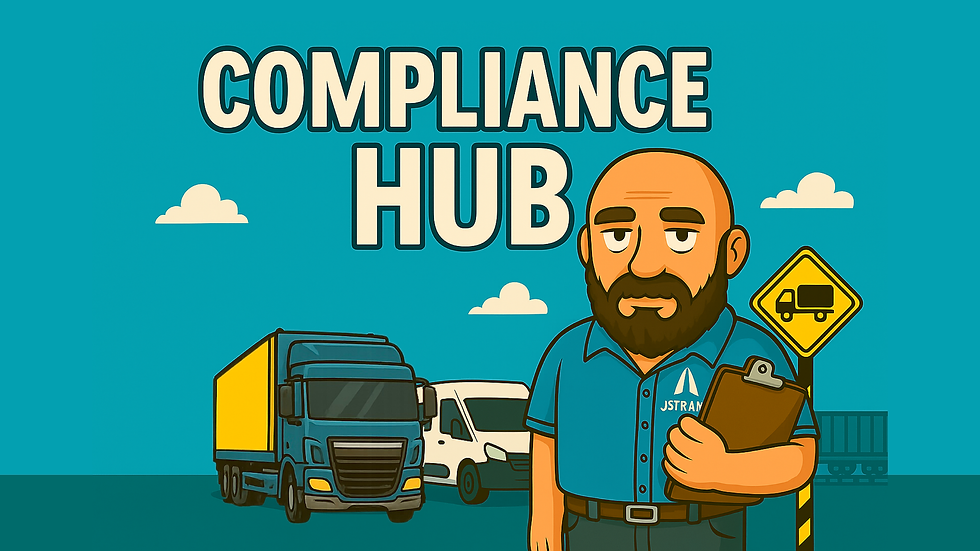What to Do if the DVSA Requests Documentation
- stuart47304
- Jul 8
- 4 min read

You’re busy running your transport business when an email or letter drops in:
“The Driver and Vehicle Standards Agency (DVSA) requests copies of your maintenance records, inspection schedules, and driver compliance documentation within 10 working days.”
Panic?
Don’t.
A request like this isn’t uncommon — especially if your vehicle has been stopped at the roadside, flagged by OCRS, or simply selected as part of a routine desk-based audit.
This post explains:
Why DVSA might contact you
What they’re looking for
How to respond
What to send (and what not to)
How to avoid last-minute stress
What happens next
Why DVSA Might Contact You
There are several reasons DVSA might request documentation from a Restricted Operator:
Reason | What it means |
Roadside stop | Something caught their attention (e.g. maintenance issue) |
OCRS alert | Your risk score may be rising |
Anonymous complaint | A third party (neighbour, ex-employee) raised a concern |
Desk-based assessment | Routine audit of your systems |
Licence renewal | You’ve applied for changes to your licence |
Pre-Public Inquiry | Information gathering for a case being built |
Receiving a letter doesn’t always mean you’re in trouble — but how you respond matters.
Step 1: Don’t Ignore It
Always read the letter or email carefully and:
✅ Note the deadline
✅ List exactly what’s being asked for
✅ Check whether the request is for scanned/email copies or original documents
If you’re unclear or need more time, contact the officer directly — DVSA is generally reasonable if you respond promptly and politely.
Step 2: Gather the Correct Records
Here’s what DVSA might typically ask for — and how to prepare each item.
✅ Maintenance Records
Preventive Maintenance Inspection (PMI) reports — last 15 months
Brake test reports — at least 4 per year
Repair invoices or job sheets
MOT test certificates
Maintenance planner or schedule
Tip: Provide documents in chronological order per vehicle.
✅ Defect Reporting System
Daily walkaround check sheets (paper or digital)
Records showing defects found and rectified
Names of drivers and dates of checks
Proof of follow-up for any defects
✅ Operating Centre Evidence (if relevant)
Proof of land ownership or permission
Evidence of planning consent (if requested)
Written confirmation of parking arrangements
✅ Driver Records
Driving licence copies
Recent DVLA licence check logs
Infringement reports or training records (if applicable)
Duty logs (if using GB Domestic Hours)
Tachograph data (if in-scope): driver card and VU downloads
✅ Policy and Procedure Documents
Maintenance policy
Defect reporting process
Record-keeping policy (if you’ve written one)
Transport-related training or disciplinary records
Step 3: Be Organised and Professional
Whether digital or paper:
✅ Clearly label each file or folder
✅ Use a consistent format (e.g. Vehicle Reg – PMI – 01.03.25.pdf)
✅ Send one email with a summary OR include a table of contents with posted files
✅ Include a short cover note explaining what’s attached
Professionalism counts. If you’re disorganised, it raises red flags — even if your vehicles are in perfect condition.
Step 4: Don’t Include What Wasn’t Requested
This is important: only send what was asked for.
Including extra documents (especially if they contain errors or outdated information) could raise unnecessary questions.
Example: You send 3 years of PMIs instead of 15 months, and one shows a missed inspection. Now DVSA wants to know why.
Stick to the request unless you’re specifically trying to demonstrate improvement or proactive measures.
Step 5: Review Before You Submit
Before hitting send (or sealing the envelope), double-check:
Are all records complete and legible?
Do the dates make sense? (e.g. no gaps in PMI schedule)
Have all defects been signed off as rectified?
Are the documents relevant and requested?
Are all drivers included?
Have you explained anything unusual?
If there are issues, acknowledge them — and explain what you’re doing to fix them.
What Happens Next?
DVSA may:
✅ Acknowledge your submission and close the case
🔁 Request additional information or clarification
📞 Call to ask questions or arrange a follow-up
📨 Refer the case to the Traffic Commissioner for review
🧾 Use the documents to inform your Operator Compliance Risk Score (OCRS)
The key is to stay responsive and cooperative.
If You’re Worried About Gaps or Issues…
If you're missing records, be honest.
In your cover note:
“We experienced a short lapse in our maintenance scheduling between March and May 2024 due to illness. This has now been addressed with a new calendar system and external support from our maintenance provider.”
Own the mistake. Show how you’ve fixed it. Most inspectors value honesty and accountability over silence or denial.
How to Avoid the Stress Next Time
The best defence is a good system. Build these habits into your business:
Habit | Benefit |
Monthly maintenance file review | Prevents overdue PMIs |
6-month driver licence check log | Keeps drivers legal |
Weekly digital scan of walkaround sheets | Easy retrieval |
Clear record-keeping policy | Speeds up audits |
Backup cloud storage | Prevents data loss |
Calendar reminders | No missed dates or downloads |
Conclusion
Getting a DVSA request for documentation can feel intimidating — but it doesn’t have to be.
If your records are up to date, clearly filed, and relevant to your operation, you’ll likely sail through. If there are gaps, communicate openly and take proactive steps.
In transport compliance, being responsive, honest and well-prepared goes a long way.
Next in the series:👉 How DVSA Target Operators: Understanding the OCRS System
